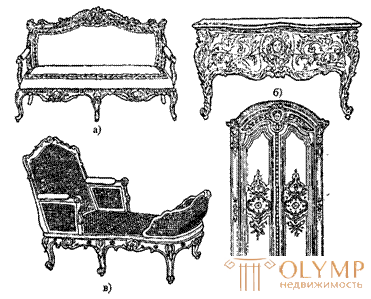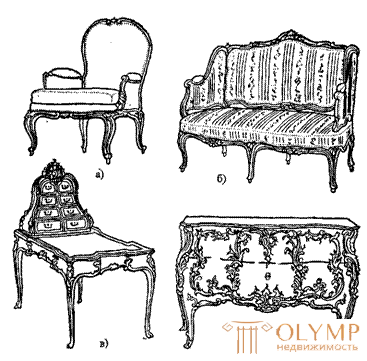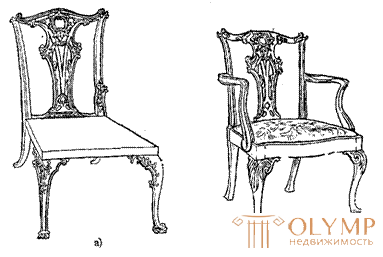
France. Early XVIII century. marked by a change in style in art. Furniture develops the so-called regency style. The furniture of the regency style retains the features of French Baroque (Louis XIV style) both in composition and in the ornamentation of products, but the shapes of objects and their decorative solution become much lighter (Fig. 1). Classic ornamental motifs are supplanted by light plant arabesques. Symmetry prevails in the ornament, but the placement of bouquets, curls, and figures is loose, which reinforces the impression of lightness.
The style of regency in furniture was most fully expressed in the works of Charles Kressan (1686-1768). The master achieved great perfection in marquetry using amaranth wood, pink and violet wood. Cressan's furniture is abundantly covered with whimsically wriggling bronze ornaments depicting the stems of plants, leaves, flowers that are wrapped around the drawers of drawers, their legs and profiles (Fig. 1.6). Cressan himself performed models of his bronze jewelry. Particularly famous were the corner ornaments he made, depicting women’s heads with high-combed hair in an elegant twist and like a flower growing out of a stem.
In the second quarter of the XVIII century. formed in the main features of the rococo style. The appearance and development of the Rococo style is associated with the name of J. O. Meissonier - a jeweler, sculptor and architect, author of numerous projects of interiors and decorative arts and crafts. In France, the style is called rocaille (French) - trimming with pieces of stone and shells, the development of which coincided with the reign of Louis XV (1723-1774), and according to the tradition adopted in the past, this style in literature is often called the style of Louis XV.

Fig. 1. Regency style furniture (France): a - sofa, 6 - Cressan's chest of drawers, b - couch, d - wardrobe
The reign of Louis XV is associated with rapid economic development and the growth of French wealth. The courtiers and aristocratic circles - owners of considerable wealth - strive for luxurious life, comfort. This circumstance is reflected in the nature of architecture and art.
Parade palace ensembles are replaced by more intimate, intimate, character structures with cozy, elegant interiors. Boudoirs and classrooms appear. The nature of the structural organization of the rooms is changing. In the interiors, furniture begins to play a more significant role, which is placed in groups in order to create greater comfort. The center of the interior is a low fireplace, covered with marble slab and trimmed with subtle relief. A mantel is decorated with clocks, candelabra, and various decorations. A large mirror placed in a luxurious frame is placed above the fireplace. In general, the value of mirrors in interior decoration, especially in salons and boudoirs, is extremely increasing. Mirrors, hung on the walls and placed on various tables, complicated the interior space and corresponded perfectly to the desire to theatrical life reigning in court circles, turning it into a kind of game. In the interiors of the Rococo style there are no monumentality and stillness, everything is subject to the desire to create the impression of movement. Preferred color solutions are also designed to create the impression of lightness and festivity. The most common color solutions are white with blue, light green, or pink (pastel colors). Mandatory accessory interior Rococo - gilding.
The idea of the interior as a holistic ensemble originates precisely in the Rococo era. In their projects, architects strive to achieve a complete stylistic unity of all the components of room decoration: wall and ceiling decor, furniture forms, drapery colors and upholstery fabrics, etc.
The most expensive exotic woods, marble, silk, tapestry, bronze, and gold are used in the decorative interiors. Rococo style was primarily the style of court-aristocratic art. In the middle of the XVIII century. passion for Chinese art, especially the collection of porcelain and varnishes, reaches its greatest development. From China came and paper wallpaper for pasting the walls of residential premises.
The rococo style features in the furniture evolved gradually: the forms and décor of furniture products became easier. The furniture for sitting has changed especially: the tips were gone, the legs were more curved, the backs were low and leaned back, the seats were wider and softer. Cabinet furniture loses its architectural structure, an acanthus leaf is less and less common in decoration, and often interpreted branches of plants and flowers are often introduced into the ornament. In the arrangement of individual figures, bouquets, curls more freedom.
As a result of striving for comfort, new types of furniture products appeared: a chaise lounge, a bergere (deep chair) (Fig. 2, c), a sofa in the form of two or three connected chairs (Fig. 2, b), a secretary on high slender legs with an inclined a folding board and a number of secret compartments (Fig. 2, c), a cardboard box (a paper cabinet), a corner cabinet, a women's writing table, a toilet with a folding mirror, round and square tables, various work tables.

Fig. 2. French rococo furniture: a - a chair made of gilded wood, b - divine, c - secretary, d - dresser
Among the items of cabinet furniture, the chest of drawers (Frenchman, commode - comfortable), as a rule, with two drawers, is the most common. The volume of the dresser (Fig. 2, d) becomes increasingly plastic — the walls are curved in vertical and horizontal directions, covered with a pattern of marquetry (branches of plants, baskets with flowers and ribbons), which is freely located on the surface of the dresser, masking its drawers.
The shapes of all types of furniture products are elegant with characteristic smooth, flowing lines.
Chairs, sofas and armchairs upholstered with velvet or trellis. Upholstery ornament less solemn. The famous tapestry series “Fables of La Fontaine”, executed according to drawings by artists Francois Boucher (1703-1770) and Jean Battiste Oudry (16S6-1755) for Versailles, and then repeatedly repeated. For furniture upholstery, carpets are made with a soft fleecy surface and floral pattern.
Expensive wood types are used for marquetry in rococo style furniture: red and rosewood, rosewood, amaranth, palm, lemon, apple, pear, maple, walnut. French furniture makers rarely resorted to artificial coloring and burning wood, preferring wood with a rich natural pattern. The wood carving in the rococo furniture was replaced with bronze overlays.
Interest in the lawsuit / law of the East, in particular China, was manifested not only in the solution of the interior as a whole, but also in individual furniture products. French masters use Chinese products in their works: for example, they make Chinese porcelain vases with bronze, and Chinese lacquer boards embed it in new furniture. In European art, imitation of Chinese models is intensifying. Since the 60s of the XVII century. seek to unravel the secret of Chinese varnishes. A whole branch of artistic production was created, and in 1713 a lacquer workshop was opened under the Gobelins manufactory. Particularly high artistic qualities differed varnishes brothers Martin, who mastered the manufacture of Chinese varnishes.
Italy. Rococo style in Italy is characterized by splendid forms and picturesque decor. Special magnificence differed lacquered furniture of Venice, which; surpassed Chinese designs and quickly supplanted them .; The furniture of Venetian masters was distinguished by its national originality in the decoration of the decor: floral ornaments, landscape motifs, figure compositions.
For almost the entire XVIII century. along with abundant carvings, intarsia continues to develop in Italian furniture, the famous master of which was Pietro Paffetti (1700-1777).
Germany. The most powerful influence of the French Rococo was on Germany, which was manifested in the decoration of the luxurious palaces of the German princes. Rococo style in Germany reaches its maturity by the middle of the XVIII century. German furniture acquires individual features: cleaner and more relaxed forms, less used is the rococo and bronze carvings. Only parts of the front fittings (door handles, keyhole guards) are made of bronze. At the same time, the sculptural, plastic beginning in furniture products becomes more pronounced: the surfaces of cabinet furniture become more curved, the corners are cut off, and energetically curved cornices are introduced.

Fig. 3. Furniture of the German Rococo: a - sideboard, b - double cabinet, in - office
A two-cabinet cabinet is widely spread (Fig. 3, b), a cupboard (Fig. 3, a), the upper part of which was designed as a glazed display case with shelves for arranging porcelain tableware, a bureau (Fig. 3, c). In some areas, such as Bavaria, they loved brightly decorated and carved furniture.
England. By the beginning of the XVIII century. English furniture acquires a distinctive character and begins to influence the furniture arts of other countries. The development of furniture in England, the beginning of the XVIII century. associated with the name of Thomas Chippendale (1718-1779), who created a variety of different furniture. His name became especially popular after the release (1754) of his book “Director” (“The Gentleman and Cabinetmaker's Director”), which included 160 engraved sheets - furniture projects. Chippendale's collection was published three times, both in England itself and in other countries.
Chippendale also gained great fame as a practitioner, heading a workshop that manufactures furniture. The furniture workshop was engaged not only in the production of individual furniture products, but also in the solution of the interior as a whole. For example, on the estate of Nostel-Pryori (one of the estates equipped with Chippendale’s workshop) everything, including door knockers, was done according to the project and under the supervision of the company. Chippendale himself was directly involved in the work, and also entered into contracts with the masters of those specialties that were not in his company (watches, curtains, mirrors, etc.). Chippendale's firm has existed for more than half a century.
Chippendale furniture has a number of features that distinguish it from French rococo furniture. In England, the fascination with Chinese art was particularly strong, which was manifested in the solution of furniture legs that have a curved shape with a wide frontal part, with eagle claws at the bottom, compressing the ball. Sometimes the eagle claws are replaced by a lion's paw or simply an influx. The frontal part is decorated with carvings, often fan-shaped sink.
A distinctive feature of the English furniture of this period is the absence of gilding and the rapidly developing use of mahogany in the manufacture of furniture. The appearance of mahogany is associated with the English colonial trade. In England for the first time in 1720 mahogany was introduced into the furniture industry. Due to its color, depth of tone, richness of texture, it quickly gained popularity in all European countries.
In England, two-tier cabinets made of walnut were solved in their own way, with a predominance of strict and rational forms, with panels surrounded by profiles. English furniture makers also have the merit of developing a folding table with lowered floors and sliding twisted twisted legs.
The furniture for sitting is various (fig. 4). The legs are straight or slightly curved, threaded. The central vertical planks of the backs have the silhouette of a violin or a tall, slender vase; later, the backs are made through. Armchairs are distinguished by maximum comfort, especially the so-called “winged” seats with high-rising armrests.

Fig. 4. Furniture of Thomas Chippendale: a - chair sample from the collection T, Chippendale (engraving), b - chair according to Chippendale drawing
Large glazed bookcases are equipped with a shaped soldering of glasses in the form of a diamond-shaped grid. The beds are usually with canopies in the form of a Chinese pagoda. A variety of desks and high floor clocks, which are almost mandatory accessory English interior.
The peculiarity of the English furniture of the XVIII century, the most characteristic of which was Chippendale, is largely due to the close relationship of the furniture makers with the architects, which was especially strong in the second half of the XVIII century. This phenomenon contributed to a unified solution to the interior and furniture, and also imposed its own seal on the decision of the actual furniture products from the point of view of a greater understanding of proportional relationships, the nature of the selection of decorative elements. Elements of Gothic, Chinese art, French Rokail are more restrained, more simple and clear. The introduction of ornamental motifs of rokail does not violate the symmetry of products, and the gothic style gets along well with the classical structure of proportions.
Что бы оставить комментарий войдите
Комментарии (0)